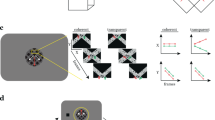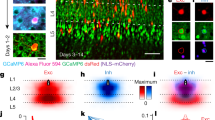Abstract
Neurons in the visual cortex typically respond selectively to the orientation, and velocity and direction of movement, of moving-bar stimuli. These responses are generally thought to provide information about the orientation and position of lines and edges in the visual field. Some cells are also endstopped, that is selective for bars of specific lengths. Hubel and Wiesel first observed that endstopped hypercomplex cells1 could respond to curved stimuli and suggested they might be involved in detection of curvature, but the exact relationship between endstopping and curvature has never been determined. We present here a mathematical model relating endstopping to curvature in which the difference in response of two simple cells gives rise to endstopping and varies in proportion to curvature. We also provide physiological evidence that endstopped cells in area 17 of the cat visual cortex are selective for curvature, whereas non-endstopped cells are not, and that some are selective for the sign of curvature. The prevailing view of edge and curve determination is that orientations are selected locally by the class of simple cortical cells3 and then integrated to form global curves. We have developed a computational theory of orientation selection4,5 which shows that measurements of orientation obtained by simple cells are not sufficient because there will be strong, incorrect responses from cells whose receptive fields (RFs) span distinct curves (Fig. 1). If estimates of curvature are available, however, these inappropriate responses can be eliminated. Curvature provides the key to structuring the network that underlies our theory and distinguishes it from previous lateral inhibition schemes6,7.
This is a preview of subscription content, access via your institution
Access options
Subscribe to this journal
Receive 51 print issues and online access
$199.00 per year
only $3.90 per issue
Buy this article
- Purchase on Springer Link
- Instant access to full article PDF
Prices may be subject to local taxes which are calculated during checkout
Similar content being viewed by others
References
Hubel, D. H. & Wiesel, T. N. J. Neurophysiol. 28, 229–289 (1965).
Dreher, B. Invest. Opthalmol. 11, 355–356 (1972).
Hubel, D. H. & Wiesel, T. N. J. Physiol. 160, 106–154 (1962).
Zucker, S. W. Comp. Vis. Gr. Im. Proc. 74–103 (1985).
Zucker, S. W. Behav. Res. Meth., Instr. Comp. 18, 608–617 (1986).
Blakemore, C., Carpenter, R. & Georgeson, M. Nature 228, 37–39 (1970).
Carpenter, R. & Blakemore, C. Expl Brain Res. 18, 287–303 (1973).
Orban, G. A., Kato, H. & Bishop, P. O. J. Neurophysiol. 42, 833–849 (1979).
Bolz, J. & Gilbert, C. D. Nature 320, 362–365 (1986).
Gilbert, C. D. J. Physiol. 268, 391–421 (1977).
McGuire, B. A., Hornung, J-P., Gilbert, C. D. & Wiesel, T. N. J. Neurosci. 4, 3021–3033 (1984).
Wiesel, T. N. & Gilbert, C. D. Quart. J. exp. Physiol. 68, 525–543 (1983).
Baker, C. L. & Cynader, M. S. J. Neurophysiol. 55, 1136–1152 (1986).
Dobbins, A. thesis, McGill University, 1987.
Parent, P. & Zucker, S. W. IEEE Trans. PAMI (in the press).
Author information
Authors and Affiliations
Rights and permissions
About this article
Cite this article
Dobbins, A., Zucker, S. & Cynader, M. Endstopped neurons in the visual cortex as a substrate for calculating curvature. Nature 329, 438–441 (1987). https://doi.org/10.1038/329438a0
Received:
Accepted:
Issue Date:
DOI: https://doi.org/10.1038/329438a0
This article is cited by
-
Diversity of spatiotemporal coding reveals specialized visual processing streams in the mouse cortex
Nature Communications (2022)
-
Variational formulas for submanifolds of fixed degree
Calculus of Variations and Partial Differential Equations (2021)
-
Intrinsic network architecture predicts the effects elicited by intracranial electrical stimulation of the human brain
Nature Human Behaviour (2020)
-
From receptive profiles to a metric model of V1
Journal of Computational Neuroscience (2019)
-
The statistical shape of geometric reasoning
Scientific Reports (2018)
Comments
By submitting a comment you agree to abide by our Terms and Community Guidelines. If you find something abusive or that does not comply with our terms or guidelines please flag it as inappropriate.



